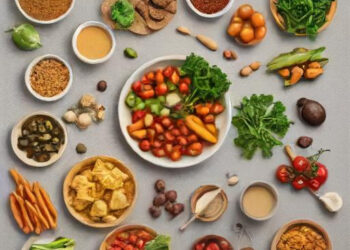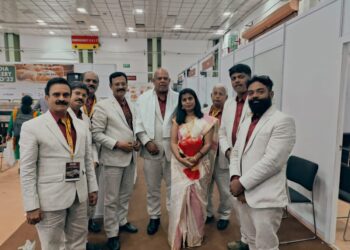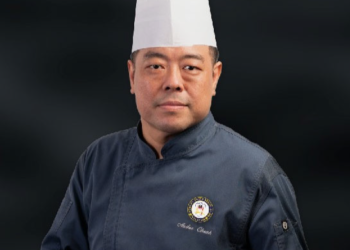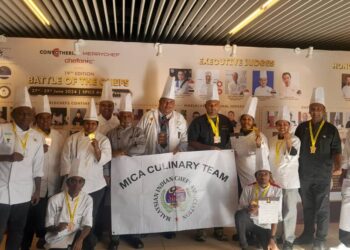By Chokkapan S (chock@imaws.org)
Have you heard of Teppanyaki Chatpati Chaat and Mexican Paani Puri? If not, it’s time to pay a visit to Gangotree – House of Designer Sweets and Chaat. Gangotree Sweets and Chaat is a popular hangout of Bangaloreans with a sweet tooth and a taste for innovation over the past 35 years running.

The business is run since 1986 by two generations of entrepreneurs from the Sethia household. The father-son duo of filmmaker H.M. Sethia and chef Raj Sethia has always believed in offering chaats with a twist. “It is smart creativity at play in Gangotree. We periodically experiment with different cuisines and flavours to delight and enthral our customers,” beams Raj, who has taken over the business from his father. The senior Sethia – a filmmaker, who produced Jab Jab Phool Khile (1965) – launched his first outlet at Highpoint.
“My father launched Gangotree in 1986 with great love for food. He was a first-generation businessman that migrated to Bangalore from Mumbai, though we were basically from Calcutta. We realised that there are not many options or outlets in terms of authentic chaats. So, our USP is to adventure in food and be uniquely innovative,” narrates Raj in an exclusive interaction with Chef Bharath. Being innovative and adventurous, he desires to revitalise people’s taste buds.
Raj has always liked experimenting with sweet and spicy dishes. And the idea of exploring innovative ways of adorning sweets to make them appealing and inventing new chaats fascinates him. “In our mithaai (sweetmeats) and chaats (hors d’oeuvre) industry, we used to be mostly dependent on halwai (confectioners/cooks). Now, things are changing and cooks are replaced with chefs. And I, personally, have innovated on my own terms since the mid-‘90s. In 1997, I created a Chinese gravy, and two years later, I rustled up a dish called Rasgulla Ki Chaat. In 2001, I innovated with Gulab Ki Pakora. I am also known for my Jamun and Jalebi Ki Chaat. I made Rasgulla with coffee – in caramel flavour – in 2014. I have been trying to reimagine and reinvent dishes all the time. God has been kind to me – a self-taught cook,” elucidates Raj.

Gangotree has a smorgasbord of sweets today, thanks to its loyal and long-time customers. “Apart from our quality, what we value most are our esteemed customers. At Gangotree, we give personalised service and often make new creations as per the customer’s specifications. Chaat is the only food that is custom-made. You can make it either spicy or sweet, or if you love chilli, you can have it hot.”
Raj has tried to introduce variations from the commonly known chaat items. His outlets feature some common chats, besides the tantalising ones curated by the enterprising chef himself. He is also credited with creating Teppanyaki Chatpatti Chaat, wherein the dish is made on a Teppanyaki style tava. Bringing together two popular food traditions of India and Japan, Raj used the Teppanyaki cooking technique to make several Indian chaat items. While traditional Teppanyaki dishes include meat and seafood and have various sauces in the dishes, Gangotree’s recipes were tweaked for its vegetarian clientele. Also, Raj is a pure vegetarian.
His idea was to fuse chaat with Teppanyaki to try something unconventional, to introduce people to this style of cooking and to make it more affordable by fusing it with Indian street food. “People used to laugh about the combination. I wouldn’t call my innovation as fusion, though.”

As a part of its innovative journey, Gangotree organised The Festival of Balls at its Mantri Square outlet. It was a vivid celebration of flavours, and of course, Paani Puri. The 10-day festival featured out-of-the-box takes on Paani Puri and Rasgullas. It had eight types of Paani Puri, with the international segment comprising the flavours of China, Italy, Mexico and Europe. The national segment presented the flavours of Delhi, Calcutta, Mumbai and Bangalore. “When I travel, I taste so many different kinds of Paani Puri – also known as Golgappa, Puchka and Patashe – in India, and I realise that each place has its distinct flavour. And I wanted to incorporate international flavours as well, so people could try varieties of food. This was a challenge and I just had to do it!” recollects Raj.
Gangotree has unique types of Kachoris and Samosas, apart from Bengali sweets like Rasmalai, Rasgullas and Jamuns. A special menu, dubbed Dial for Pleasure, in its inn – Munch Booth – has pastas like Pasta Makhani, Kadai Veg Pasta, Pasta Arrabiata and a Spicy Salsa variant. There are also novel pizzas such as Manchurian Pizza and Thai Green Curry Pizza, besides an American one. “I also created different pastas and pizzas at an Indian street food festival organised with the tastes of younger generation in mind. It is imperative that you directly interact with your customers all the time to know their tastes. Building healthy relationships always helps,” says Raj. It is evident from its three outlets in Bangalore, despite braving headwinds during the Covid-19 lockdown.






